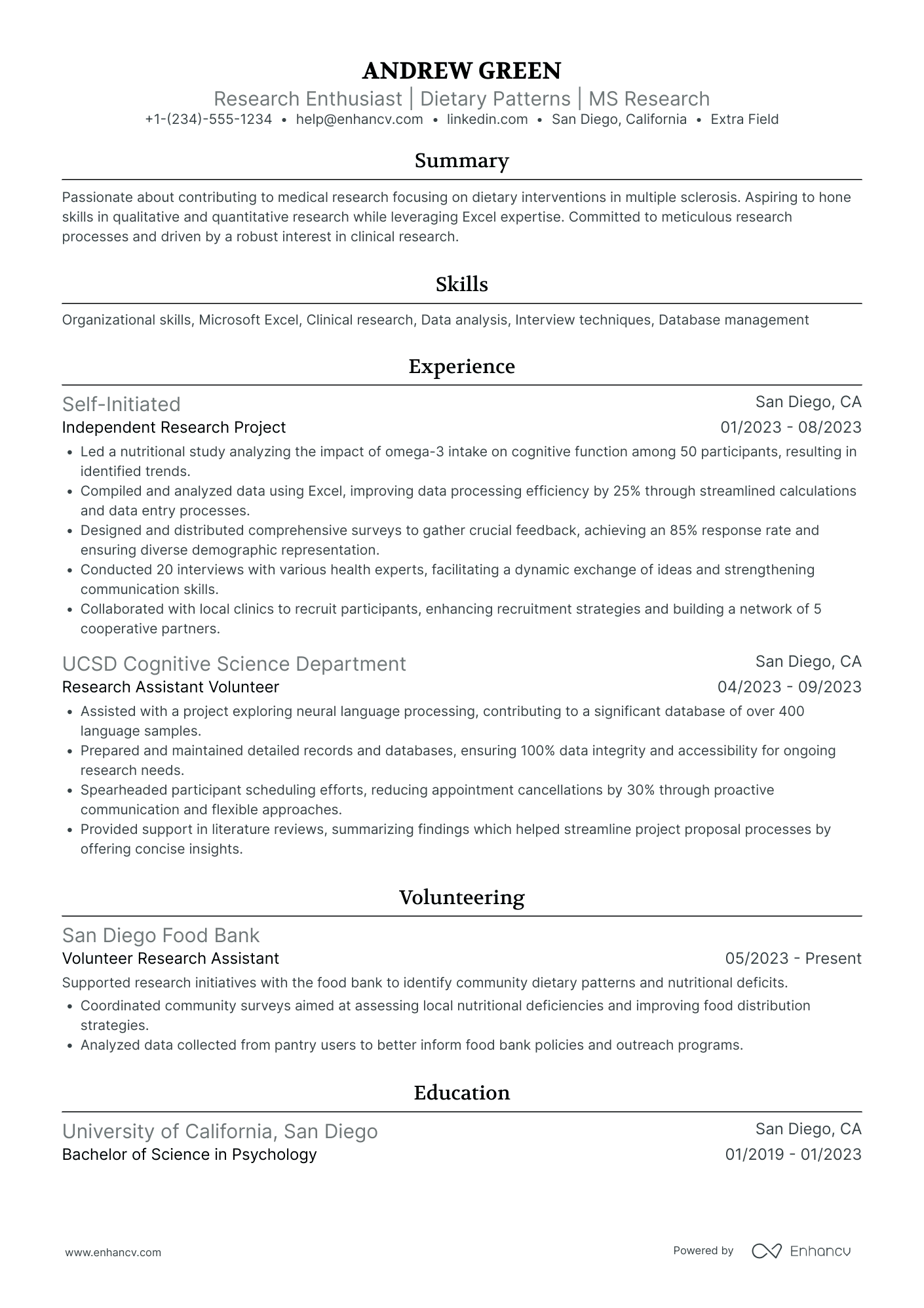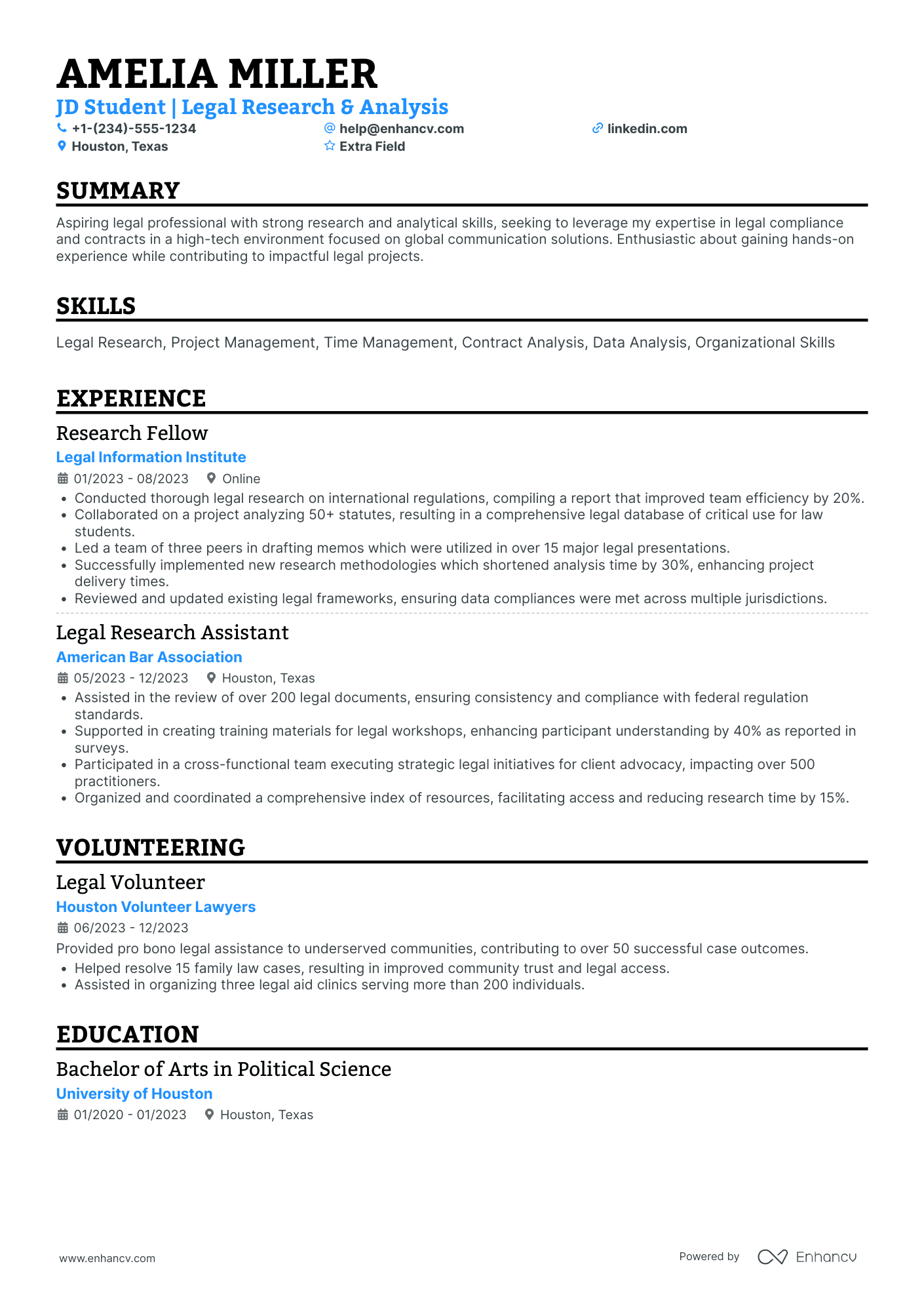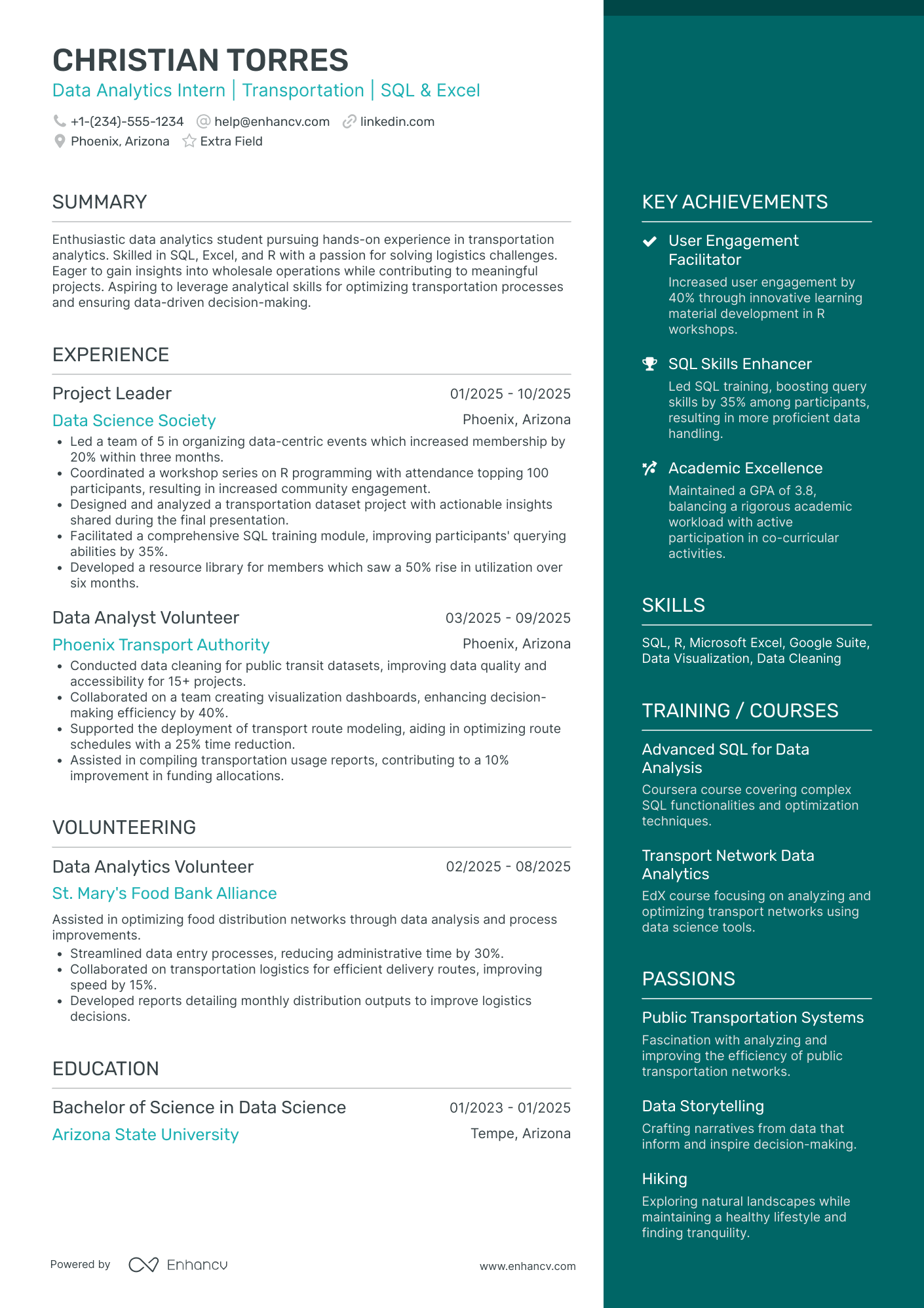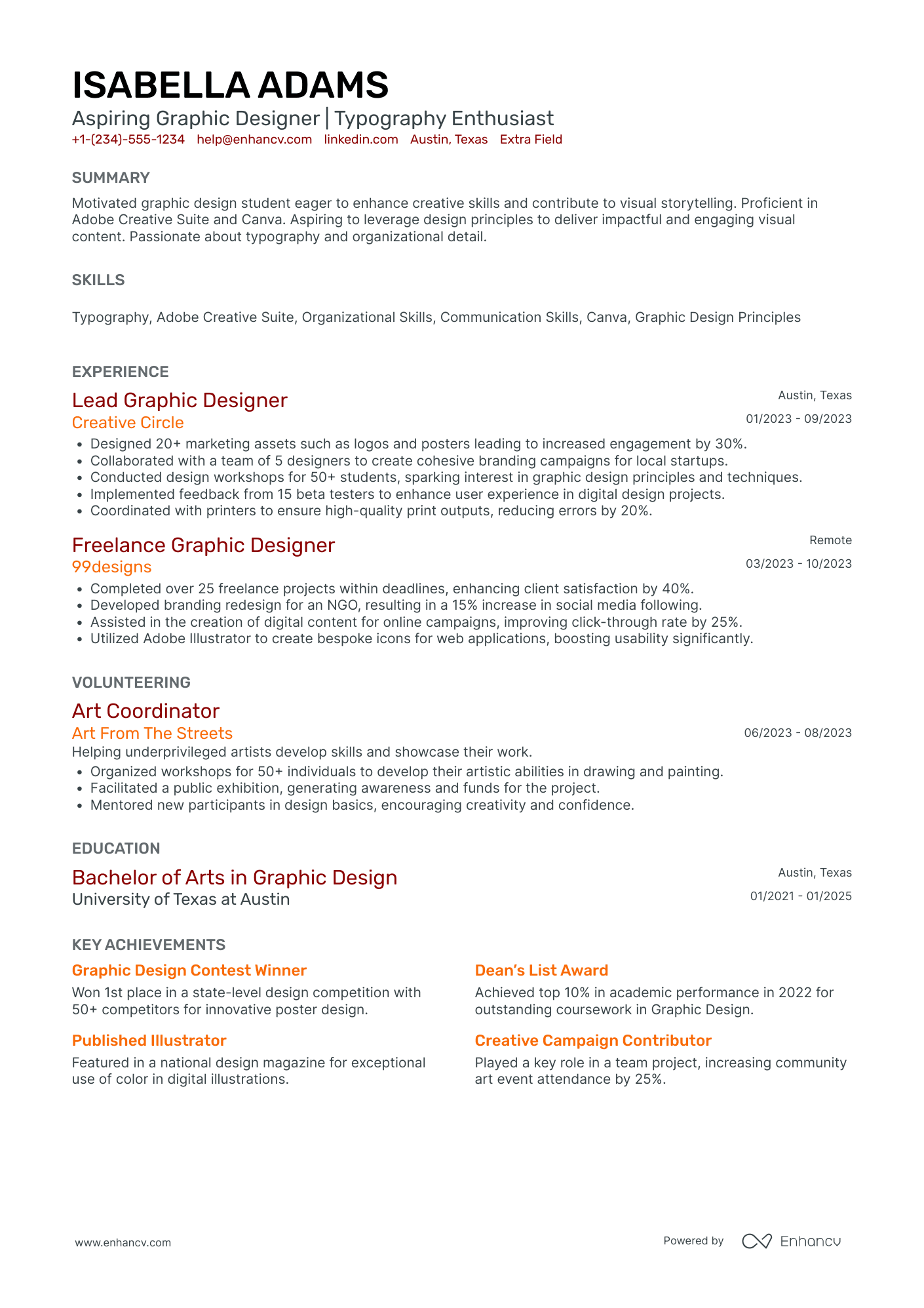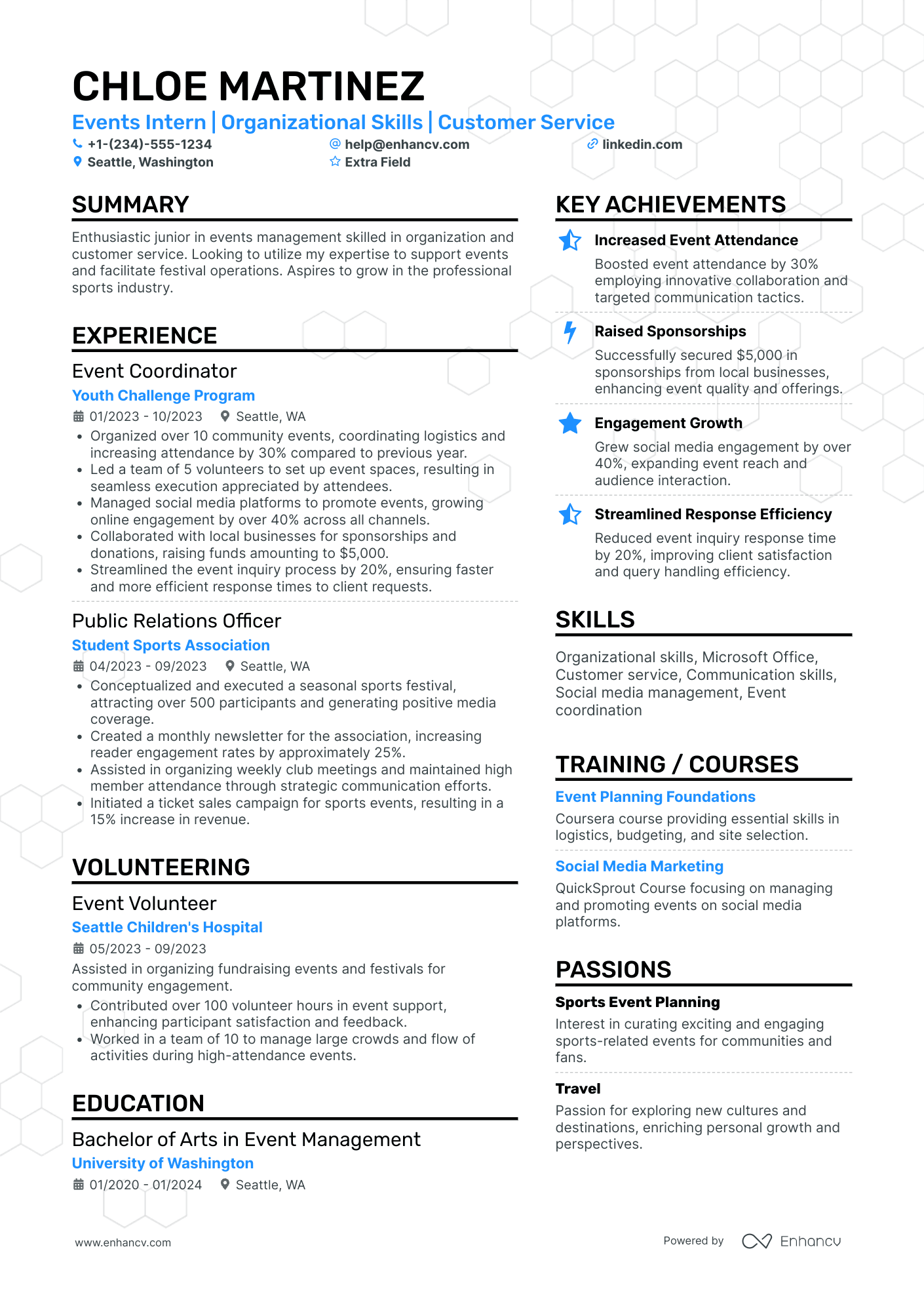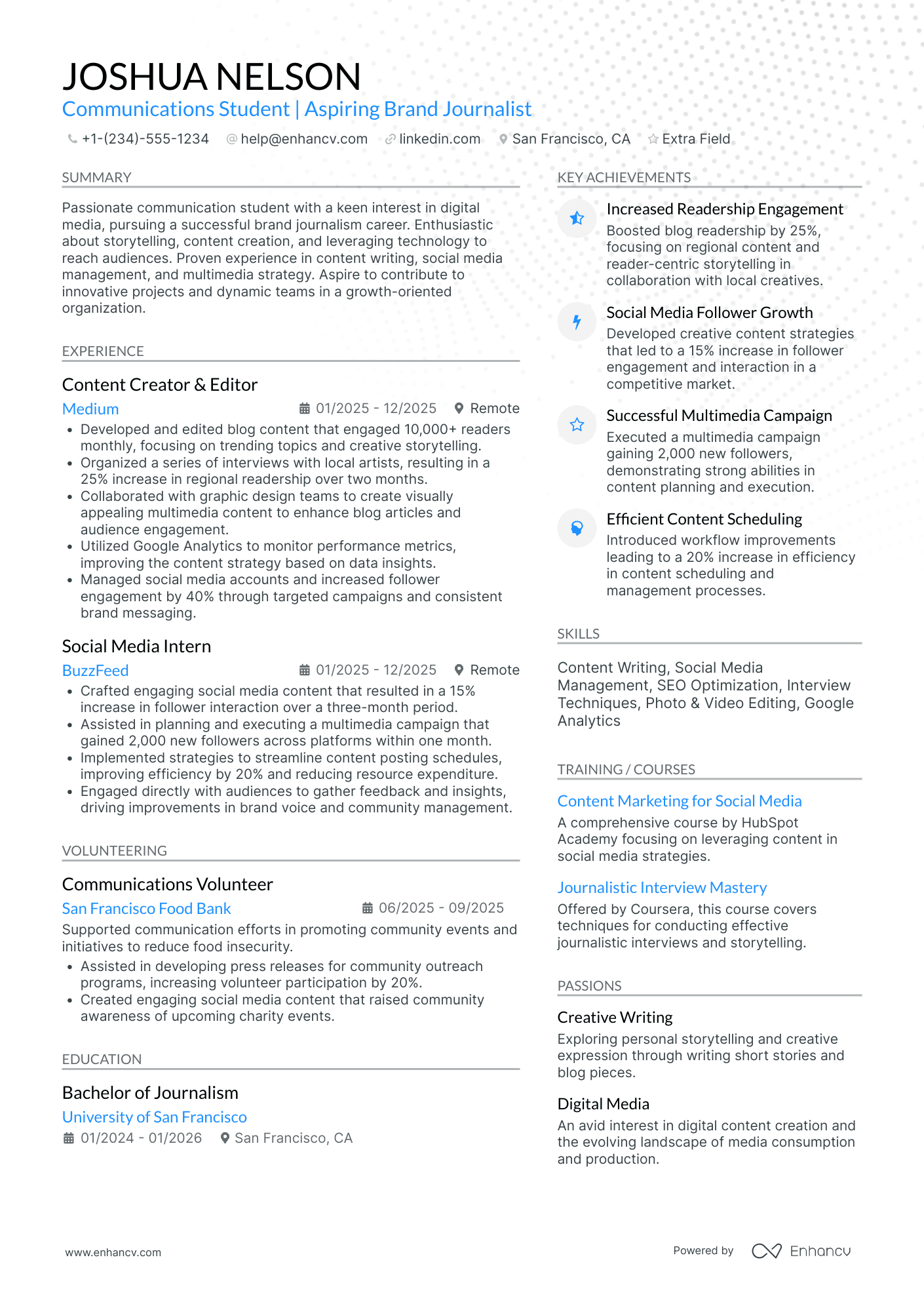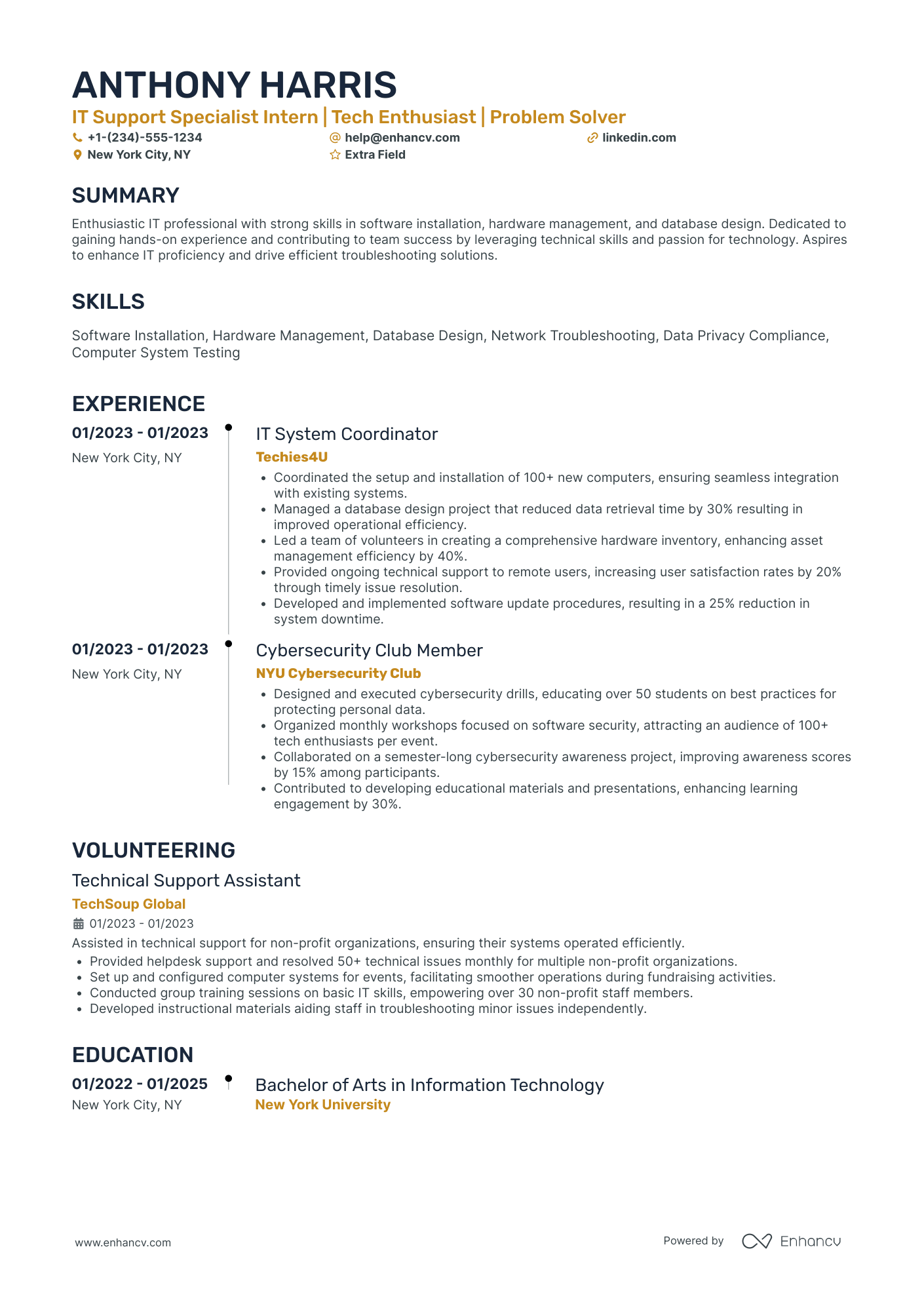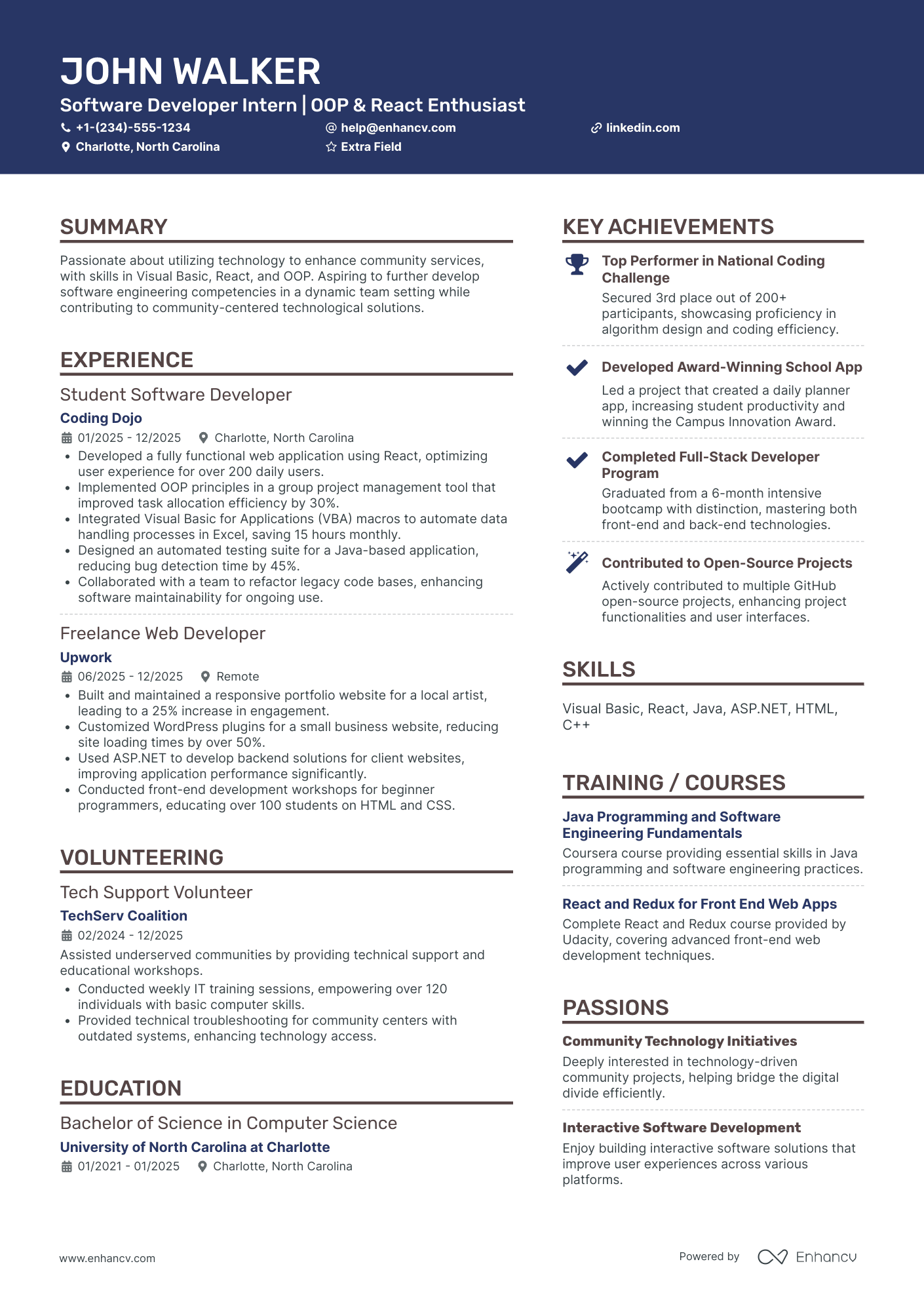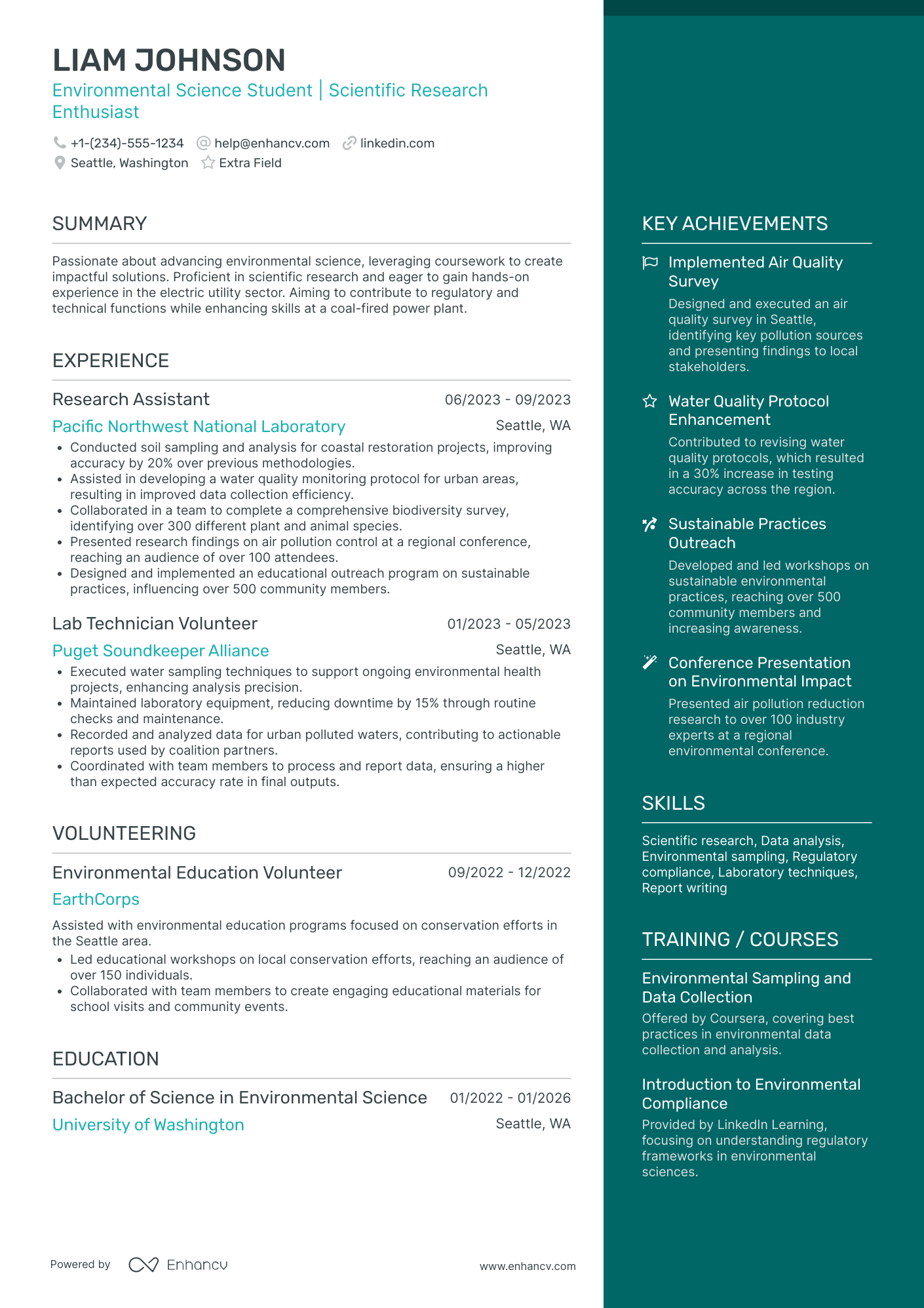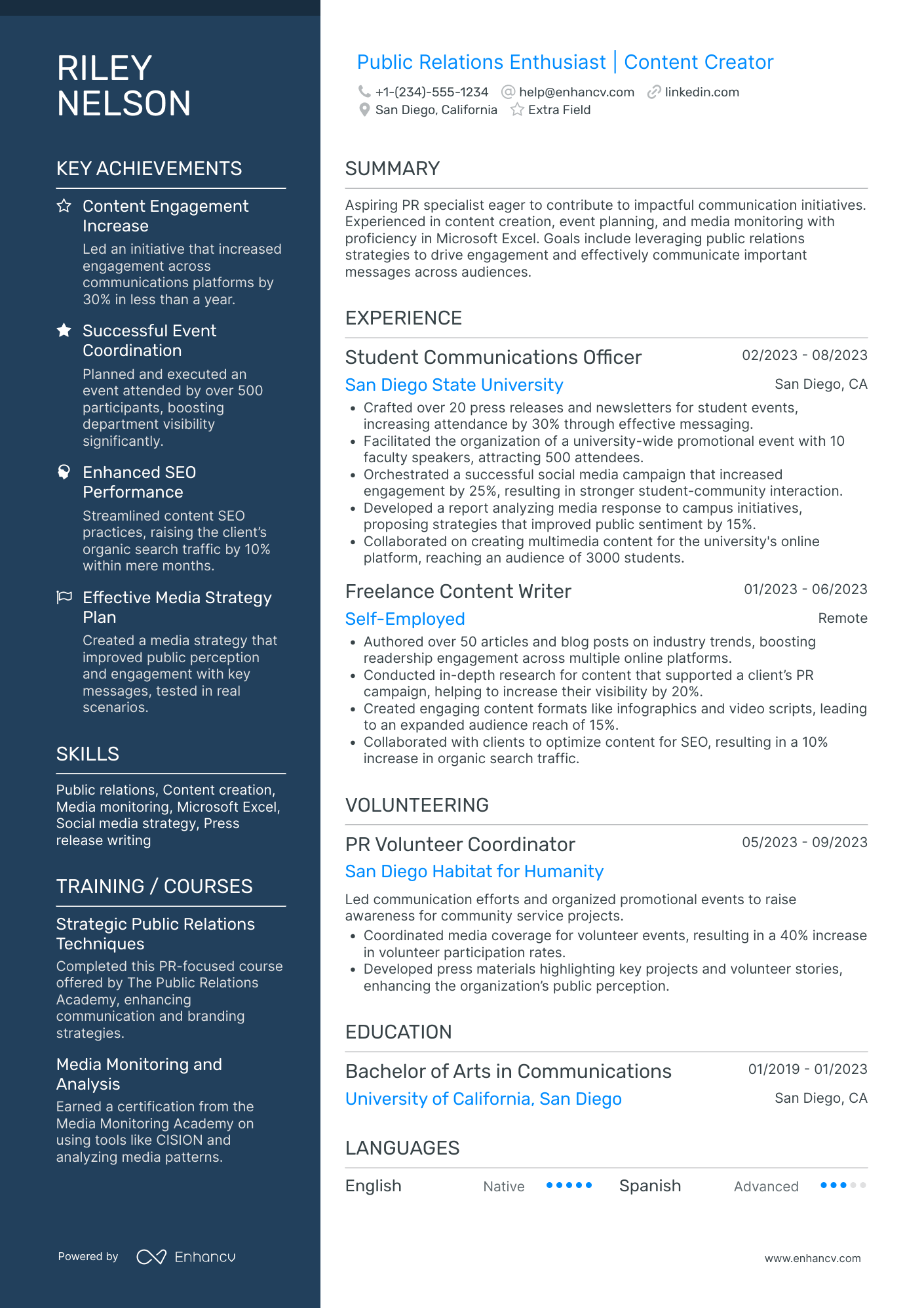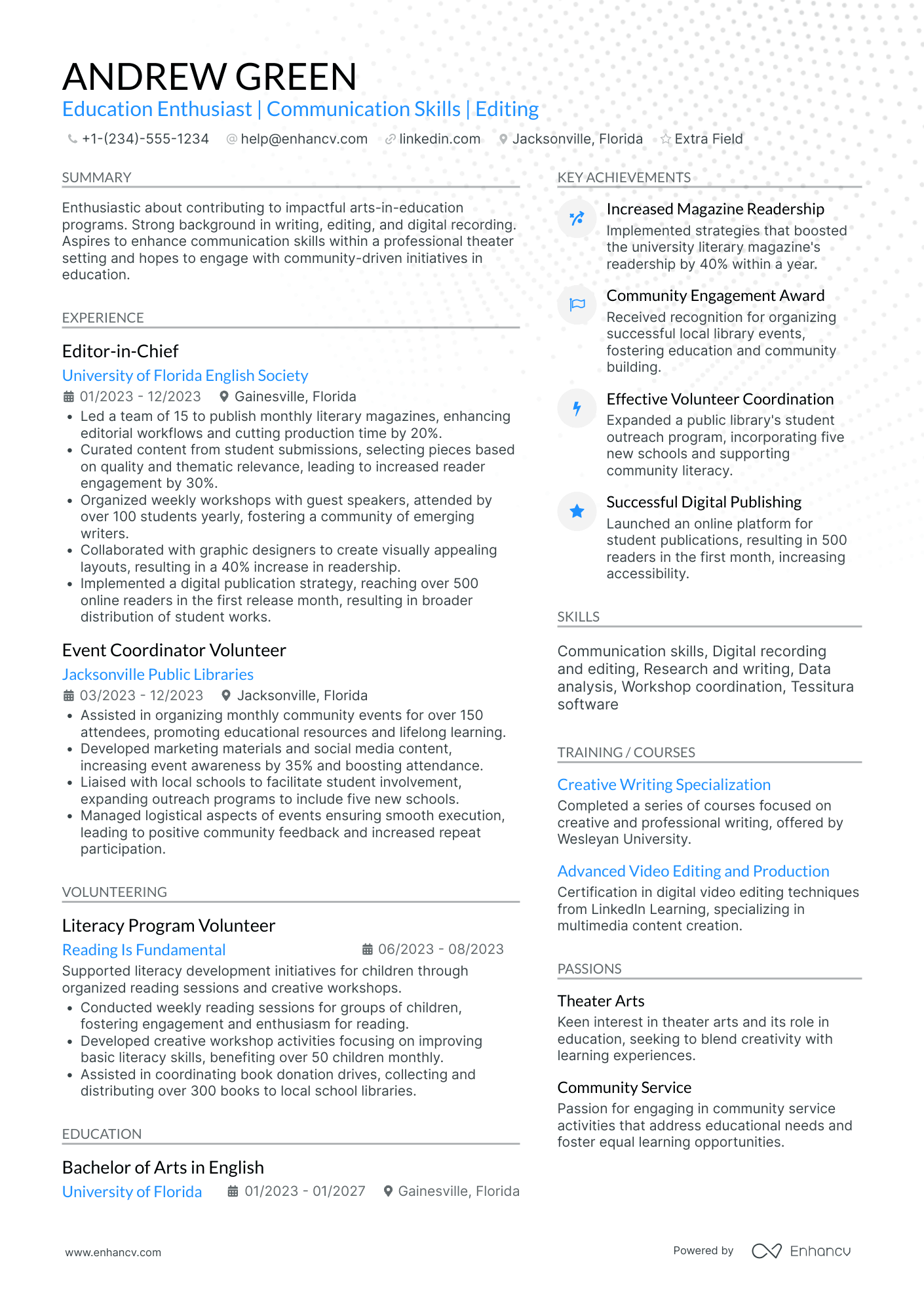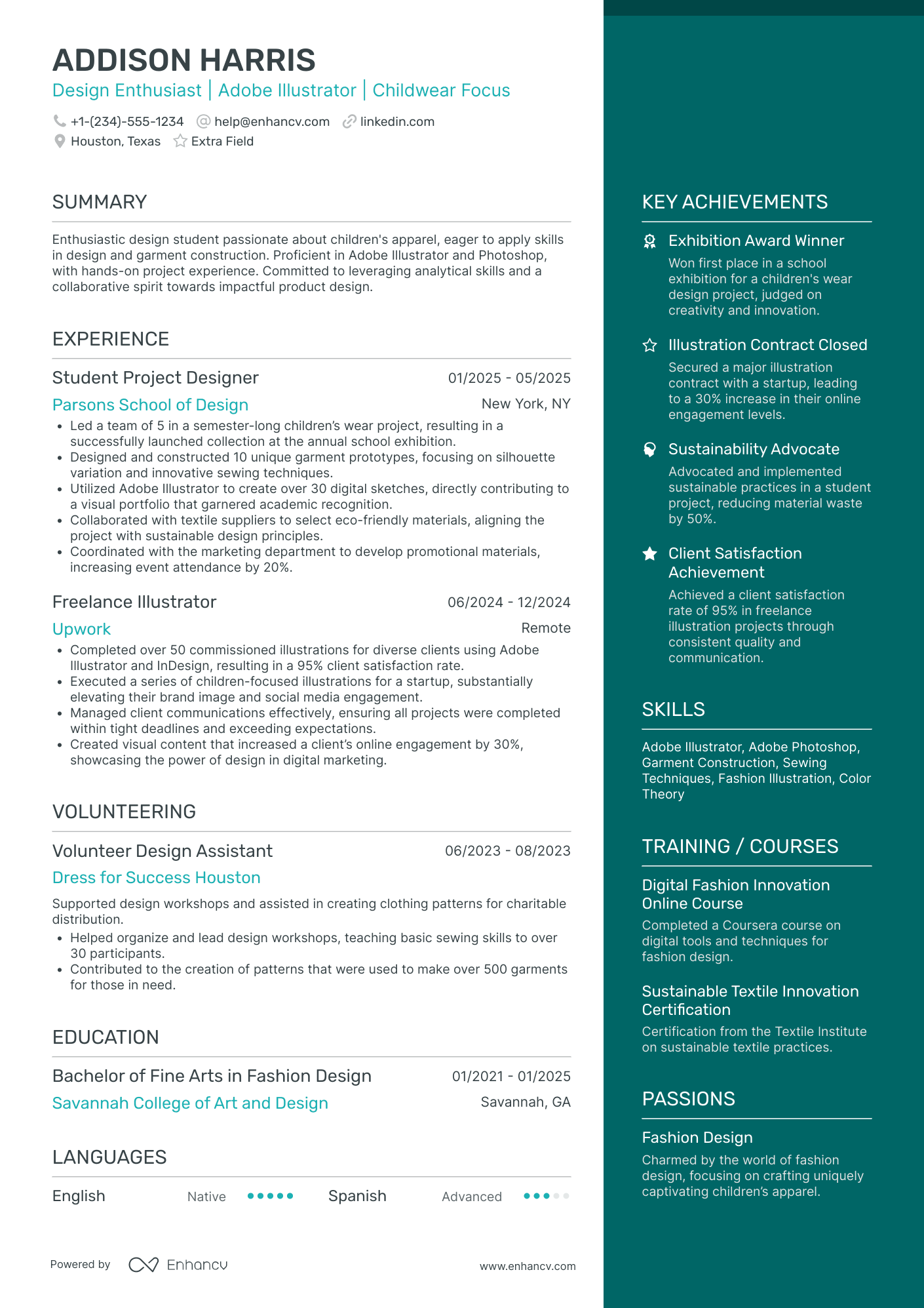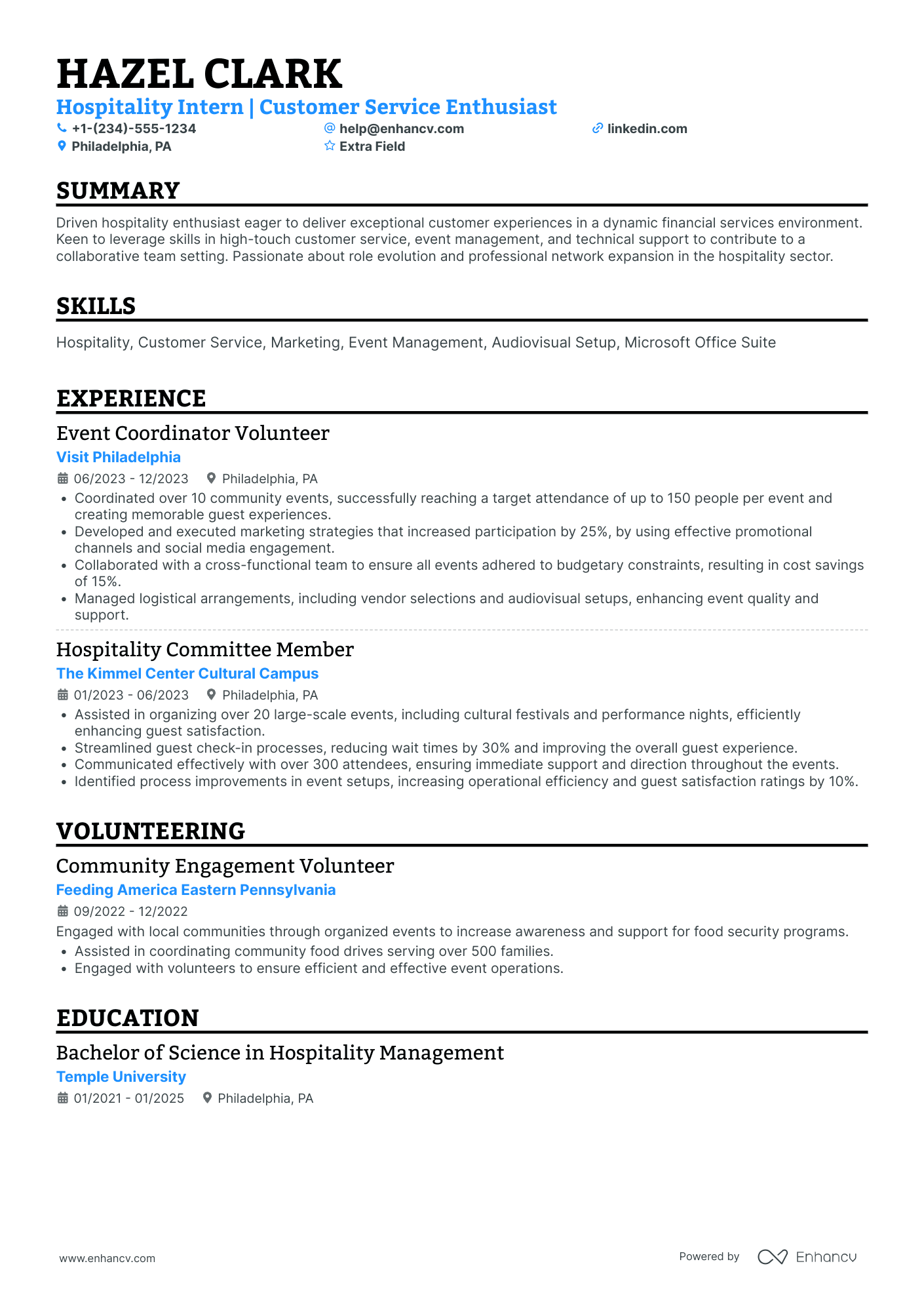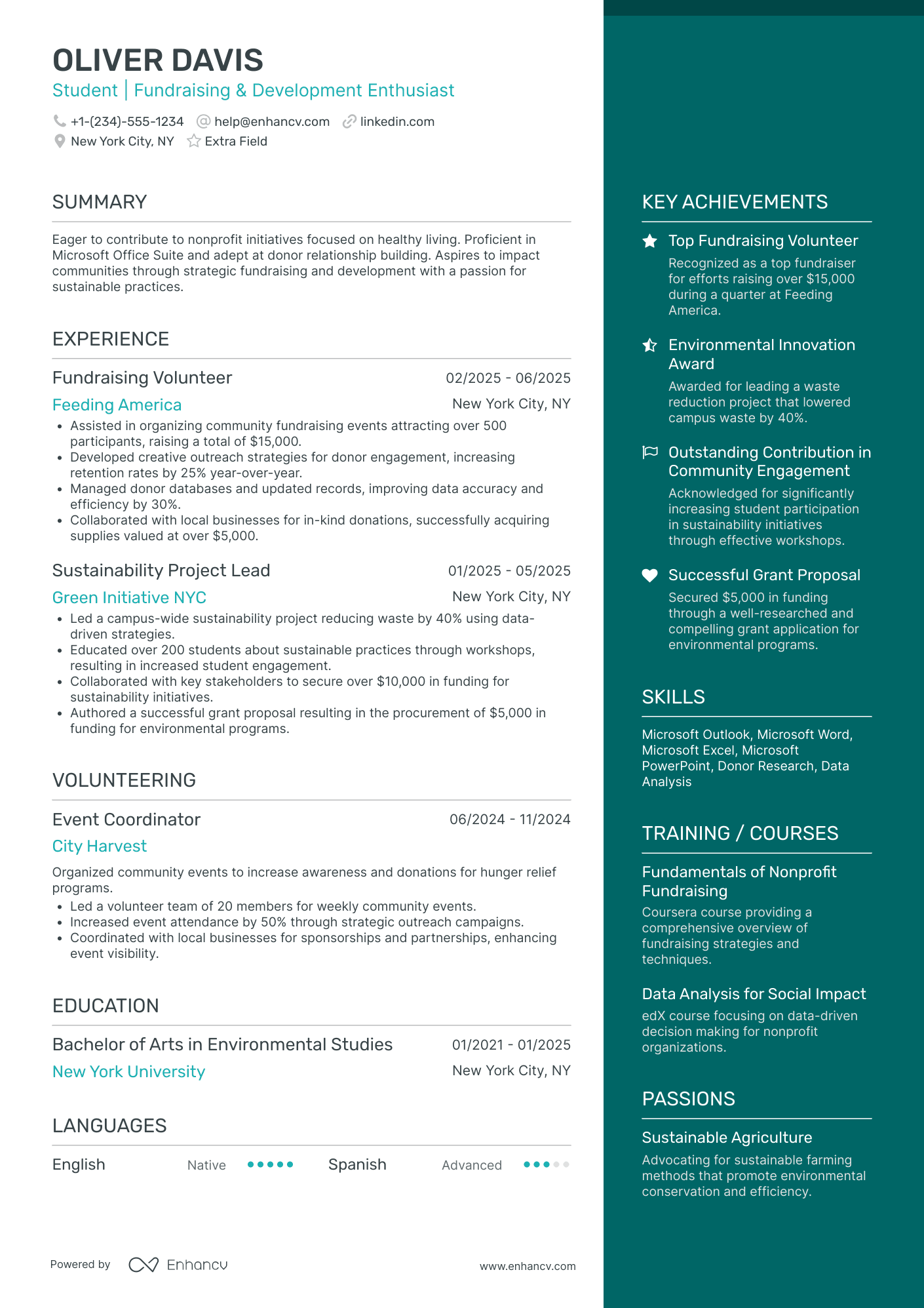“internships help you build your resume and gain valuable on-the-job skills,” says a Glassdoor article. That’s like stating the obvious. To land that internship, you still need a resume that looks every bit as professional as an executive’s. Feeling caught in a vicious circle already?
Unlike the standard student resume, which lists any and all types of jobs, an intern resume is a bit different. It's not just about showcasing your job history—it’s about highlighting specific skills and experiences that align precisely with the internship you’re eyeing. Every section of your resume should support your career aspirations and speak to the needs of potential employers.
It’s safe to say that the key to a standout intern resume is customization. In this guide, we’ll show you how to tailor your resume to reflect who you are and who you want to become professionally. Also:
- What resume format to use to direct recruiters’ attention to your top skills and achievements.
- How to write about your previous experience and back it up with concrete examples of success.
- What are transferable skills and why they matter when building an intern’s resume.
- How to create an effective education section and let HR staff know you’re serious about your career path.
- How to further personalize your resume with additional sections and an intern cover letter for maximum impact.
Before we dive in, check out these resume guides for specific internship roles:
- Product Manager intern Resume
- Software Engineer intern Resume
- Data Analyst intern Resume
- Engineering intern Resume
- Social Media intern Resume
- Social Work intern Resume
- Accounting intern Resume
- Design intern Resume
- Computer Science intern Resume
- Human Resources intern Resume
- Finance intern Resume
- Sales intern Resume
- Marketing intern Resume
- Data Science intern Resume
- IT intern Resume
- Real Estate intern Resume
Resume format for interns
Remember, resume layouts can vary by country – for example, a Canadian resume format could look different.
According to NACE, paid interns are nearly twice as likely to secure employment after graduation compared to non-interns. A stunning 68% of these students receive job offers from the same organizations where they interned. Now, you can imagine how important it is to make the best impression possible from the start.
A well-crafted resume can jump-start your career in your chosen field and potentially within your preferred company. You simply have to convince HR staff and applicant tracking systems (ATS) how driven and hard-working you are. Let us explain.
Almost 90% of organizations use ATS to scan your resume for keywords. This is a quick way to identify if you’ve understood the assignment by simply counting how many times the keywords from the job posting appear on your resume.
Therefore, when building your intern resume, you should tailor it to the specific job you’re applying for. The first thing you need to take care of is the resume format.
The very first thing I tell every intern on the first day is that their internship exists solely on their resume…
Jay Samit, Serial Entrepreneur
We usually speak of three types of resume formats.
- Reverse-chronological resume: This is the most common format and lists your work experience in reverse chronological order, starting with the most recent. It's useful if you have some relevant work experience or have been involved in internships, part-time jobs, or volunteer work related to your field of study. However, if you're just starting out in your career, it's probably best to avoid this format—it'll just highlight your lack of experience.
- Functional resume: This format focuses on your skills and experience rather than the reverse-chronological order of your work history. It's a good option for interns who may not have a lot of work experience but have skills relevant to the job they're applying for. You can organize it by skills or projects, highlighting contributions or achievements related to each skill.
- Combination (hybrid) resume: As the name suggests, this format combines elements of both reverse-chronological and functional resumes. It allows you to highlight your relevant skills at the top of your resume followed by your work history.
For most interns, the hybrid or functional resume often works best, especially if you lack solid previous experience. These formats let you emphasize your skills, academic projects, or volunteer work that apply to the job you are seeking.
Resume design tips
- Font: Use professional fonts like Rubik, Lato, or Volkhov, size 10-12 p. Anything less would be difficult to read. Depending on the industry, traditional fonts like Arial and Times New Roman might be requested. Don’t worry, they won’t affect ATS scanning like some fancy custom fonts would.
- Margins: Another factor contributing to your file’s readability is the resume margins. Keep them between 0.5 to 1 inch on each side.
- Length: The recommended resume length for interns is one page.
- Header: Include your name, phone number, professional email with your real name (not the clever nickname you use on TikTok), and а link to your LinkedIn profile. If you’re considering a role in the creative field, you want to include a link to your portfolio which is a perfect way to demonstrate your skills without saying a word. However, think twice before adding a photo to your resume, as it’s frowned upon in some US states, even illegal.
- Resume template: Choose a clean, traditional template. The benefit of single-column resumes is their flexibility across industries, especially law, accounting, finance, and engineering. They can also accommodate more text without looking messy.
- File formatting: Save your resume as a PDF to preserve formatting, unless specified otherwise in the job listing. Name your file professionally, like “FirstNameLastNameintern_Resume.pdf”.
- Proofread: If you aren’t confident in spelling or grammar, use our AI-powered resume checker to see if your resume is error-free.
Is your resume good enough?
Drop your resume here or choose a file. PDF & DOCX only. Max 2MB file size.
Next, it’s time to decide which resume sections you’ll need on your internship resume.
The top sections on an internship resume
- An education section detailing your academic background and relevant coursework.
- A strong skills section to demonstrate your job-relevant capabilities.
- Previous experience highlighting practical industry exposure or interest.
- An objective statement at the top of your resume, serving as a professional pitch.
- Projects and achievements showcasing your applied knowledge and results.
Below is the information you need to provide in these sections in order to create both a readable and engaging resume.
What recruiters want to see on a resume for an internship
- Relevant educational background aligning with job requirements.
- Internship or part-time job experience that shows practical skills.
- Extracurricular activities implying teamwork and leadership.
- Technical skills specific to the industry or role.
- Academic projects related to the job proving real-world application.
Consider this the bare structure of your resume—a well-thought-out document with a list of keywords ready to be strategically placed. Let’s focus on optimizing your content to improve your chances of getting past the ATS.
How to write an intern resume experience section
Most interns feel overwhelmed by this stage. How do you organize an experience section with so little relevant experience? Yes, you might have scanned items at Target in the summer, but will that help if you want to land an internship in Google’s BOLD program?
The answer is yes. Here’s why.
Recruiters know that interns come with little to no experience. They don’t expect you to list every single table you’ve waited on in the past couple of years. They do expect, however, to get an overview of the transferable skills you’re bringing to their organization. They want to see how you made a difference in your previous roles (be it paid or volunteer) and how this can translate into your next career move.
Let’s go back to the Target cashier who wants to do an internship with Google. Look at this intern’s experience section.
- •Handled daily financial transactions at the checkout.
- •Provided customer service and resolved inquiries.
- •Promoted store loyalty programs to customers.
- •Organized the front-end area to streamline the checkout process.
This experience section entry seems to miss the mark.
- It lacks specificity: The bullet points are very general and don’t highlight specific skills or achievements that could translate into value for a role at Google. They lack quantified outcomes that could show the applicant's impact and effectiveness in their role.
- Missing relevance to the role: The tasks described are typical for a cashier position but don't connect directly to the skills and experiences sought in a tech-oriented internship like Google's BOLD program. Skills related to technology, innovation, project management, or analytical thinking, are more likely to be relevant.
- Absence of description: The experience item has no description section, which could be an opportunity to frame routine responsibilities in a way that underscores transferable skills like fast learning, dealing with complex transactions, or handling pressure.
- Generic presentation: Overall, the presentation of the experience is straightforward and lacks a strategic angle that aligns it with the goals and values of a tech company like Google. It fails to tell a compelling story of why this experience is relevant and how it prepares the candidate for an internship in such a dynamic and innovative setting.
The point here is not to lie about your skills and responsibilities, but to think of a clever way to match them with the requirements of the target (no pun intended) role. See how this can be done below.
- •Processed over 1,000 transactions per week with a 99.5% accuracy rate, ensuring reliable financial handling.
- •Assisted approximately 150 customers daily, providing information and resolving issues to enhance customer satisfaction.
- •Contributed to a 10% increase in-store loyalty card sign-ups by effectively promoting the benefits to customers.
- •Implemented a new organization system for the front-end area, reducing clutter and improving the checkout process efficiency.
This revised version checks the following boxes:
- Quantified achievements: The bullets provide specific metrics such as "processed over 1,000 transactions per week with a 99.5% accuracy rate". These quantified results illustrate the applicant's direct impact on business operations, reflecting a strong work ethic and precision.
- Demonstrated skills: Detailing assistance to approximately 150 customers daily showcases the cashier's ability to manage high volumes of customer interactions, highlighting skills in communication and problem-solving, which are critical in any role at Google where enhancing user experience is key.
- Operational improvements: By mentioning the implementation of a new organization system that improved the checkout process, the candidate illustrates their initiative and ability to implement changes that lead to efficiency improvements. This aligns with Google's culture of innovation and optimization.
- Relevance to teamwork and adaptability: Managing financial transactions and customer service in a high-traffic retail environment shows the candidate's ability to work effectively in fast-paced, dynamic settings. This experience applies to the often high-pressure environments at Google.
- Professional presentation: The inclusion of a clear description at the beginning shows the candidate can present information in a professional manner. The effective use of details and strategic placement of quantified data make the section compelling, which is critical for capturing the attention of recruiters.
Way more impressive, right? These aspects make the experience section relevant, suggesting that even experience outside of the tech industry can be valuable if presented in a way that highlights transferable skills and individual impact.
Tech, finance, and consultancy are the sectors with the highest-paying internships. Unsurprisingly, they’re the most competitive, too. So, a standout resume is non-negotiable.
How to quantify impact on your resume
Speaking of individual impact—the numbers and figures depend on the job you’re applying for. Here are a few suggestions on how you can measure your successes from previous experience.
- Highlight the percentage increase in efficiency due to a process improvement you implemented, demonstrating effectiveness and innovation.
- Document the exact number of users who benefited from a software tool or application you developed, showing your impact on user engagement.
- Quantify the reduction in expenses from any cost-cutting measures you introduced, emphasizing your contribution to financial health.
- Mention the increase in follow-up rates from your communication strategies, indicating your ability to enhance customer or client retention.
- Describe the growth in audience size from digital marketing campaigns you managed, reflecting your skills in expanding market reach.
- Specify the volume of data you analyzed or managed, underscoring your analytical and detail-oriented capabilities.
- Report the number of events or projects coordinated, showcasing your organizational skills and ability to multitask effectively.
- Detail the increase in positive feedback or ratings on projects or services you were involved in, highlighting your commitment to quality and customer satisfaction.
Remember, these are examples. Use them to brainstorm contributions you made in your academic and work life and be specific when describing them.
According to an article on smallbizgenious.net, among students who undertake internships, just over half participate in more than one. Of these, 27% complete two internships, 13% complete three, and a highly ambitious 2% undertake six or more internships. Imagine those resumes!
How do I write an internship resume with no work experience
The simple answer is to build a targeted resume. This means optimizing your resume for the job you want. It’s about being smart about the details such as keywords, use of language, and a professional profile. Yes, you may be lacking the experience, but you have your educational background and coursework to support your application.
You also have the benefit of having no pre-existing expectations looming over you, as you’re probably still studying at high-school. (The usual age for American students starting an internship is 17).
Here are a few more sections to consider including if you want to amplify your intern resume:
- Projects and coursework achievements: Detail any academic or personal projects relevant to the role. Describe what the project involved, your role, the skills you used, and any outcomes or what you learned.
- Extracurricular activities: Include positions in clubs, sports, student government, or volunteer work, especially those where you had a leadership role or which are relevant to the internship.
- Awards and honors: Mention any academic or extracurricular awards and why you received them.
- Professional affiliations: If you're a member of any clubs or organizations related to the field, list them to show your dedication and network in the industry.
- Certifications: Include any relevant certifications that demonstrate your commitment to the industry or proficiency in specific areas.
The key takeaway here is to provide evidence for everything you mention on your resume. Don’t say “edited the college newspaper”. Instead, say “Managed the editorial process for the college newspaper, enhancing content quality and increasing readership by 20%.” That’s the only way to make recruiters forget about your lack of experience.
Next, let’s talk about the skills section which can greatly compensate for a limited work history.
How to list your relevant intern skills
So, you’ve picked up a lot of skills throughout your education. You should attempt to highlight those skills in your resume for an internship, pointing out both technical skills and soft skills that you’ve gained along the way.
Hard skills are the technical skills that allow you to stand out from the competition. Some of them may be gleaned through study or certificates and may include your knowledge of coding languages, your understanding of cybersecurity, or your adeptness in customer relationship management software.
Here are some general tips for the hard skills on your resume:
- List all job-relevant skills in a dedicated space on the resume.
- If you mention them in a different section, quantify those skills (‘Increased sales by 15% using a new CRM software,’).
- Don’t exaggerate your abilities.
- Use the job description as a guide for which skills to emphasize.
That last point matters for ATS scanners as they comb through your resume to find specific keywords, some of which are skills.
Here are some tech skills you might have acquired during your studies that can be useful when looking for an internship.
The best hard skills for an internship resume
- Data analysis
- Statistical software (e.g., SPSS, SAS)
- Programming (Python, Java)
- Database management (SQL)
- Web development (HTML, CSS, JavaScript)
- Project management software (Jira, Trello)
- Graphic design (Adobe Photoshop, Illustrator)
- CAD software (AutoCAD, SolidWorks)
- Financial modeling
- Cloud computing (AWS, Azure)
- Machine learning tools (TensorFlow, PyTorch)
- Cybersecurity fundamentals
- Mobile app development (Swift, Android Studio)
- Network configuration
- Blockchain technology
- Robotics
- Biotechnology
- Electronic circuit design
- Video editing software (Final Cut Pro, Adobe Premiere)
- Spreadsheet proficiency (Excel, Google Sheets)
Soft skills are people skills and are much more difficult to quantify than hard skills. But they’re just as important for applicants.
Here are some tips for including soft skills on a resume:
- Avoid generic wording like “Good communication skills”.
- Tailor your soft skills to the job that you’re applying for.
- Use action verbs when describing your soft skills. For example, instead of simply saying “critical thinking”, you can support it with a quantified achievement —“Applied critical thinking to solve complex problems and make informed decisions, reducing project costs by 15%.”.
- Use language and phrases that match the company’s values.
- Use your cover letter to shed light on your soft skills, giving concrete examples. Be ready to elaborate on each skill you list when you get the interview call.
Some companies may pride themselves on their inclusive culture, which is something that you could highlight on your resume. Maybe, as leader of a club at your university, you created initiatives to make sure that no one felt out of place. Mention that on your resume.
Here’s a pool of interpersonal skills you can consider including in your intern resume.
The best soft skills for an internship resume
- Communication
- Teamwork
- Adaptability
- Problem-solving
- Leadership
- Creativity
- Time management
- Conflict resolution
- Critical thinking
- Emotional intelligence
- Attention to detail
- Initiative
- Stress management
- Interpersonal skills
- Organizational skills
- Persuasion
- Negotiation
- Patience
- Empathy
- Active listening
Now, let’s focus on the most impactful part of an intern’s resume—the education section.
How to list education and certifications on your resume
You're new to your field, and much of your experience stems from your time spent in educational settings. Embrace this by including projects you've worked on, any theses you've written, or other relevant academic experiences in your resume.
Here’s what you should include in your education section:
- Degree title
- University, college, or other institution
- Location (optional)
- Years attended
- Your GPA (if above 3.5)
- Honors, Dean’s list, and awards (if applicable)
- Student accomplishments
- •Recipient of the Dean's List for four consecutive semesters.
- •Completed key courses: Consumer Behavior, Digital Marketing Analytics, Strategic Brand Management, Market Research Techniques
See? This person stands a great chance of landing a paid internship in a wide range of organizations and industries, such as advertising, media networks, retail chains, tech companies, and financial services, to name a few.
Next, consider enhancing your resume with relevant certifications. These are highly valued across all professions, often more so than formal education, as they show your career interests to employers. Even if you are fresh out of college—or perhaps still enrolled— numerous free certification courses are available to explore.
The best certifications for an intern’s resume
The next section of this guide will teach you how to craft your resume objective to show relevance and motivation.
How to write your intern resume objective
Another must-have section of an intern resume is the objective statement sitting at the top of the page, just below the header. While resume summaries offer an overview of a candidate’s career, objectives are focused on your unique value proposition. You’ll need a summary when you gather more than 3 years of work experience.
Another difference between the two is the length. Objective statements are no longer than 3 sentences, which allows entry-level candidates and interns to be concise and to the point. Here are the simple steps to write an effective objective:
- An opening sentence presenting your best strength or professional goal.
- A sentence highlighting your skills and qualifications that are relevant to the position you’re applying for.
- A strong closing sentence convincing recruiters you and the employer share the same values.
The key thing to do in your objective (as well as the entire resume) is to adapt it to the specific position and organization you are applying for.
Look at a resume objective for a student internship at the U.S. Department of State.
This is a breakdown of why this objective works well for an intern:
- It's direct and specific: The objective clearly states what the intern wants to do and the skills they plan to use, which shows they understand the role and are focused on how they can contribute.
- Highlights the right skills: It mentions analytical and research skills, which are crucial in a foreign affairs environment.
- Professional tone: The objective is written professionally yet approachably, fitting for a high-level internship where effective communication is key.
89.4% of Congress employees have interned previously. 90% of those internships are paid.
Optimize your resume summary and objective for ATS
Drop your resume here or choose a file.
PDF & DOCX only. Max 2MB file size.
Additional sections for an intern’s resume
Your resume is still in progress and maybe you have enough space for some other resume sections that would make it more engaging. Enhancv’s resume builder lets you re-arrange existing sections and add new ones with the click of a button.
Here’s what you can consider including if it’s relevant to the job you’re applying for.
- Volunteer experience: If you've done any volunteer work that’s related to your field or shows leadership and initiative, definitely add it. It's a great way to show your dedication and values.
- Hobbies or interests: Particularly for internships, showing that you're involved in activities outside of academics can illustrate your teamwork, leadership, and time management skills.
How to put a projects section on a resume
Academic or personal projects are a great way to showcase how you apply your knowledge and skills in real-world scenarios. Experienced candidates would normally list them under the education section, but you have the opportunity to shift the focus from your limited work experience by isolating projects in an extra section. Here’s how:
- Mention the title of the projects
- Add your role
- Add project duration dates and, optionally, location
- Write up to 3 bullets describing your contributions
- •Analyzed the impact of environmental, social, and governance (ESG) criteria on investment decisions.
- •Conducted case studies on the financial viability of sustainable business practices within the technology sector.
- •Developed a framework to evaluate green bonds and sustainable investment funds.
Including a projects section like this one on a resume can be highly impactful for an intern, particularly if you’re seeking an internship in the circular economy or green technology sectors. It’s important to remember that everything you put on your resume should be carefully tailored to match the specific requirements of the role you’re targeting.
Key takeaways
This guide should give you all the tools you need to create a strong resume for different internship opportunities. Whether it's your first time applying or you're updating your current resume, here are some essential tips to help you stand out:
- Tailor your resume: Customization is crucial. Adapt your resume to the specific internship role by using keywords from the job description and focusing on relevant experiences and skills.
- Choose the right format: Depending on your experiences, choose from reverse chronological, functional, or hybrid resume formats to best showcase your skills and relevant work or academic projects.
- Highlight key skills and achievements: Use concrete examples to demonstrate your achievements and skills. Quantify your contributions whenever possible to add credibility.
- Optimize for ATS: Ensure your resume is ATS-friendly by including keywords from the job listing and sticking to a simple, professional format.
- List education and certifications: Clearly list your educational background, relevant coursework, and any certifications that enhance your qualifications for the internship.
- Add an objective statement: A well-crafted objective statement at the top of your resume can summarize your goals and demonstrate your enthusiasm for the position.
Intern resume examples
By Role

